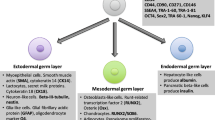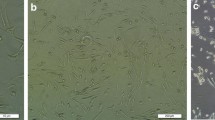Abstract
Putative stem cells have been isolated from various tissue fluids such as synovial fluid, amniotic fluid, menstrual blood, etc. Recently the presence of nestin positive putative mammary stem cells has been reported in human breast milk. However, it is not clear whether they demonstrate multipotent nature. Since human breast milk is a non-invasive source of mammary stem cells, we were interested in examining the nature of these stem cells. In this pursuit, we could succeed in isolating and expanding a mesenchymal stem cell-like population from human breast milk. These cultured cells were examined by immunofluorescent labeling and found positive for mesenchymal stem cell surface markers CD44, CD29, SCA-1 and negative for CD33, CD34, CD45, CD73 confirming their identity as mesenchymal stem cells. Cytoskeletal protein marker analysis revealed that these cells expressed mesenchymal stem cells markers, namely, nestin, vimentin, smooth muscle actin and also manifests presence of E-Cadherin, an epithelial to mesenchymal transition marker in their early passages. Further we tested the multipotent differentiation potential of these cells and found that they can differentiate into adipogenic, chondrogenic and oesteogenic lineage under the influence of specific differentiation cocktails. This means that these mesenchymal stem cells isolated from human breast milk could potentially be “reprogrammed” to form many types of human tissues. The presence of multipotent stem cells in human milk suggests that breast milk could be an alternative source of stem cells for autologous stem cell therapy although the significance of these cells needs to be determined.
Similar content being viewed by others
References
da Silva Meirelles L, Chagastelles PC, Nardi NB. Mesenchymal stem cells reside in virtually all post-natal organs and tissues. J Cell Sci 2006; 119: 2204–13.
Petersen BE, Bowen WC, Patrene KD et al. Bone marrow as a potential source of hepatic oval cells. Science 1999; 284: 1168–70.
Kopen GC, Prockop DJ, Phinney DG. Marrow stromal cells migrate throughout forebrain and cerebellum, and they differentiate into astrocytes after injection into neonatal mouse brains. Proc Natl Acad Sci USA 1999; 96: 10711–16.
Zuk PA, Zhu M, Mizuno H et al. Multilineage cells from human adipose tissue: implications for cell-based therapies. Tissue Eng 2001; 7: 211–28.
Salingcarnboriboon R, Yoshitake H, Tsuji K et al. Establishment of tendon-derived cell lines exhibiting pluripotent mesenchymal stem cell-like property. Exp Cell Res 2003; 287: 289–300.
Seo BM, Miura M, Gronthos S et al. Investigation of multipotent postnatal stem cells from human periodontal ligament. Lancet 2004; 364: 149–55.
De Bari C, Dell’Accio F, Tylzanowski P, Luyten FP. Multipotent mesenchymal stem cells from adult human synovial membrane. Arthritis Rheum 2001; 44: 1928–42.
Sabatini F, Petecchia L, Tavian M et al. Human bronchial fibroblasts exhibit a mesenchymal stem cell phenotype and multilineage differentiating potentialities. Lab Invest 2005; 85: 962–71.
Jones EA, English A, Henshaw K et al. Enumeration and phenotypic characterization of synovial fluid multipotential mesenchymal progenitor cells in inflammatory and degenerative arthritis. Arthritis Rheum 2004; 50(3): 817–27.
Tsai MS, Lee JL, Chang YJ, Hwang SM. Isolation of human multipotent mesenchymal stem cells from second-trimester amniotic fluid using a novel two-stage culture protocol. Hum Reprod 2004; 19(6): 1450–6.
In’t Anker PS, Scherjon SA, Kleijburg-van der Keur C et al. Amniotic fluid as a novel source of mesenchymal stem cells for therapeutic transplantation. Blood 2003; 102(4): 1548–9.
Kim J, Lee Y, Kim H et al. Human amniotic fluid-derived stem cells have characteristics of multipotent stem cells. Cell Prolif 2007; 40: 75–90.
Musina RA, Belyavski AV, Tarusova OV et al. Endometrial mesenchymal stem cells isolated from the menstrual blood. Bull Exp Biol Med 2008; 145: 539–43.
Cregan MD, Fan Y, Appelbee A et al. Identification of nestin-positive putative mammary stem cells in human breastmilk. Cell Tissue Res 2007; 329: 129–36.
Ke XS, Qu Y, Goldfinger N, Rostad K et al. Epithelial to mesenchymal transition of a primary prostate cell line with switches of cell adhesion modules but without malignant transformation. PLoS ONE 2008; 3: e3368.
Moss LG, Rhodes CJ. Beta-cell regeneration: epithelial mesenchymal transition pre-EMTpted by lineage tracing? Diabetes 2007; 56: 281–2.
Miao Z, Jin J, Chen L, Zhu J, Huang W, Zhao J, Qian H, Zhang X. Isolation of mesenchymal stem cells from human placenta: comparison with human bone marrow mesenchymal stem cells. Cell Biol Int 2006; 30: 681–7.
Phadnis SM, Joglekar MV, Venkateshan V et al. Human umbilical cord blood serum promotes growth, proliferation, as well as differentiation of human bone marrow derived progenitor cells. In Vitro Cell Dev Biol Anim 2006; 42: 283–6.
Shetty P, Bharucha K, Tanavde V. Human umbilical cord blood serum can replace fetal bovine serum in the culture of mesenchymal stem cells. Cell Biol Int 2007; 31: 293–8.
Li A, Simmons PJ, Kaur P. Identification and isolation of candidate human keratinocyte stem cells based on cell surface phenotype. Proc Natl Acad Sci USA 1998; 95: 3902–7.
Richardson GD, Robson CN, Lang SH et al. CD133, a novel marker for human prostatic epithelial stem cells. J Cell Sci 2004; 117: 3539–45.
Shackleton M, Vaillant F, Simpson KJ et al. Generation of a functional mammary gland from a single stem cell. Nature 2006; 439: 84–8.
Uchida N, Buck DW, He D et al. Direct isolation of human central nervous system stem cells. Proc Natl Acad Sci USA 2000; 97: 14720–5.
Xin L, Lawson DA, Witte ON. The Sca-1 cell surface marker enriches for a prostate-regenerating cell sub-population that can initiate prostate tumorigenesis. Proc Natl Acad Sci USA 2005; 102: 6942–7.
Lochter A. Plasticity of mammary epithelia during normal development and neoplastic progression. Biochem Cell Biol 1998; 76: 997–1008.
Boutinaud M, Jammes H. Potential uses of milk epithelial cells: a review. Reprod Nutr Dev 2002; 42: 133–47.
Böcker W, Moll R, Poremba C et al. Common adult stem cells in the human breast give rise to glandular and myoepithelial cell lineages: a new cell biological concept. Lab Invest 2002; 82: 737–46.
Author information
Authors and Affiliations
Corresponding author
Rights and permissions
About this article
Cite this article
Patki, S., Kadam, S., Chandra, V. et al. Human breast milk is a rich source of multipotent mesenchymal stem cells. Hum Cell 23, 35–40 (2010). https://doi.org/10.1111/j.1749-0774.2010.00083.x
Received:
Accepted:
Issue Date:
DOI: https://doi.org/10.1111/j.1749-0774.2010.00083.x




